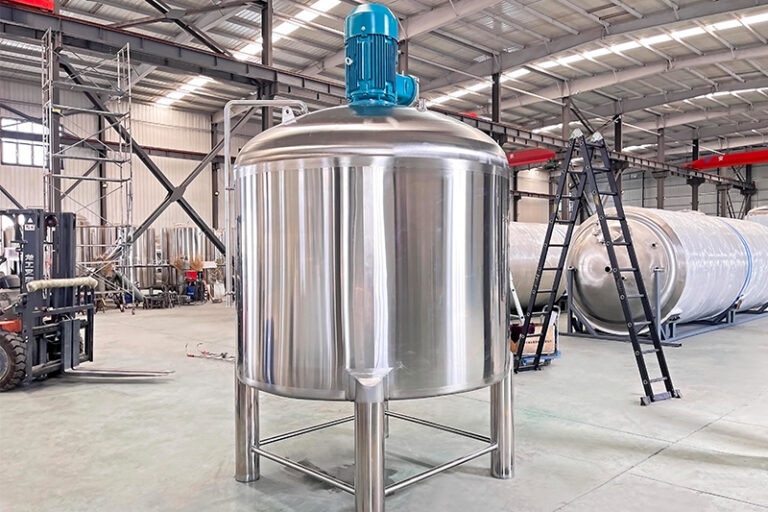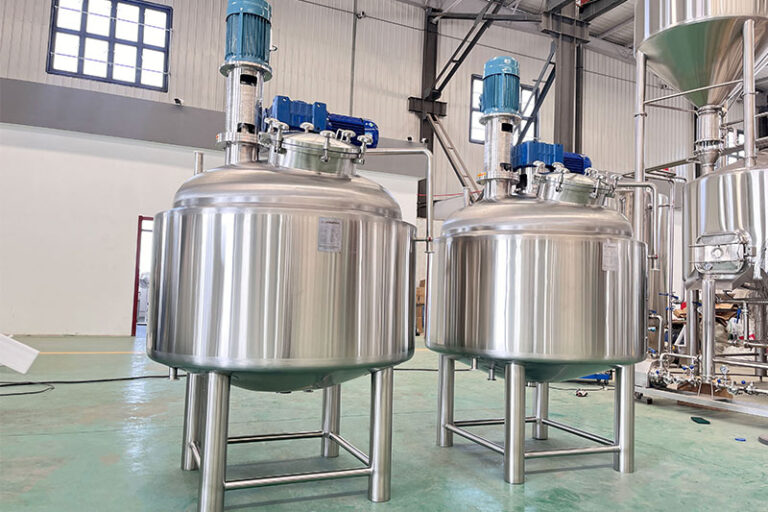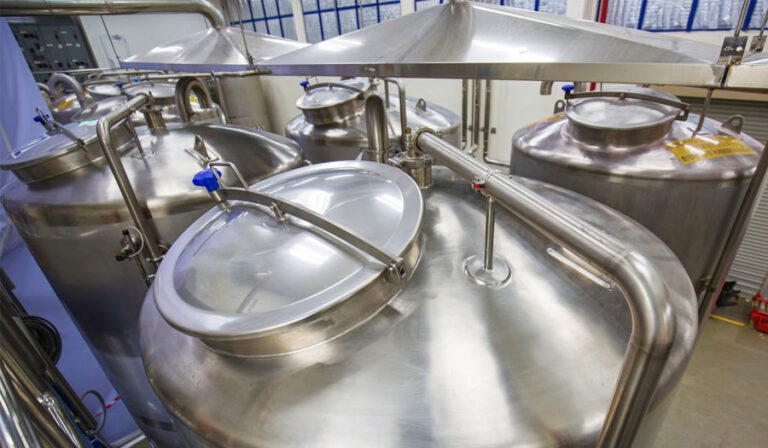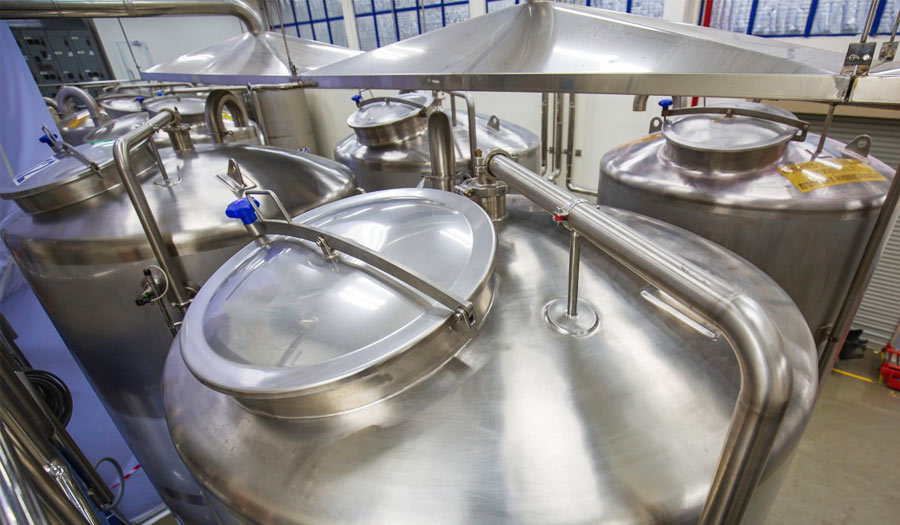As a multifunctional and efficient key equipment in the industrial field, stainless steel mixing tanks have various types to meet the sophisticated needs of different industries and processes. The types of stainless steel mixing tanks are divided into different types based on function and design structure, which not only demonstrates the flexibility and innovation of industrial equipment but also brings great convenience and efficiency improvement to the production processes of various industries.
What is a stainless steel mixing tank?

The structure of the stainless steel mixing tank
The structure of stainless steel mixing tanks is relatively complex and diversified to meet the needs of different industries and processes. Generally speaking, stainless steel mixing tanks are mainly composed of the following key parts:
Tank body
- Material: The tank body is made of high-quality stainless steel material, which has good corrosion resistance and sealing, and can ensure that the material is not contaminated by the outside world during the mixing process.
- Structure: The tank body can be designed as a single-layer, double-layer, or three-layer structure according to demand. The single-layer structure is simple and suitable for general mixing needs; the double-layer structure has a jacket layer, which can be used for heating or cooling; the three-layer structure adds an insulation layer to improve energy efficiency and reduce heat loss.
- Shape: The shape of the tank body is mostly cylindrical, and the bottom can be designed as a conical or elliptical head structure as needed to facilitate the discharge and cleaning of the material.
Agitator
- Anchor agitator: The anchor agitator has a horizontal axis and the blades are similar to anchors. These blades sweep the material from the tank wall to the center to promote radial flow. When it works at a low speed, it can produce a horizontal circulation flow. Suitable for medium and high-viscosity fluids and materials that easily adhere to the tank wall.
- Paddle agitator: Paddle agitators have flat, paddle-shaped blades that extend radially from the agitator shaft. The blades are usually wide and flat, similar to the shape of a paddle or scraper. They are often used where strong axial and radial circulation in the liquid is not required, such as solid-liquid mixing, crystallization, and gentle mixing.
- Propeller agitator: Propeller agitators have axial flow blades that produce liquid flow parallel to the agitator shaft. They are simple and low-cost. This type of agitator is suitable for low-viscosity fluids and simple mixing applications, especially for producing suspensions.
- Turbine agitator: Turbine agitators have excellent characteristics in flow pattern design. By changing the design, the flow pattern of the fluid in the reaction vessel can be changed to radial flow or axial flow. For gas dispersion operations, radial turbine impellers are used, while axial turbine impellers are used for chemical reactions, suspended solids, and mixing of miscible liquids.
- Helical agitator: The helical blades are configured to produce a twisting or spiral motion, providing effective mixing in both the axial and radial directions. The configuration of the helical blades produces a twisting or spiral motion, providing effective mixing in both the axial and radial directions.
Tank cover and accessories
- Tank cover: The tank cover is used to seal the tank body to prevent the material from splashing out or foreign impurities from entering during the mixing process. The tank cover can be equipped with accessories such as a feed inlet, discharge port, observation window, pressure gauge, thermometer, etc.
- Accessories: such as sight glasses, manholes, breathing valves, cleaning balls, etc., are used to observe the state of materials in the tank, personnel entering the tank for maintenance, balancing the pressure in the tank, and cleaning the tank body.

Support and installation
- Support device: The support device is responsible for supporting the entire mixing tank to ensure its stable operation. There are two support methods: column-type support foot floor-standing installation and platform support ear installation, which can be selected according to site conditions.
- Installation: The installation of the mixing tank must comply with relevant standards and specifications to ensure the safety and stability of the equipment. During the installation process, the inlet and outlet pipe connections, electrical wiring, and safety protection measures of the equipment must also be considered.
Heating and cooling device
According to process requirements, the stainless steel mixing tank can be equipped with a heating or cooling device. The heating device can be equipped with an electric heating pipe, steam heating, or thermal oil heating; the cooling device can be equipped with a water circulation cooling or refrigerant cooling.
Types of stainless steel mixing tanks
Classification by function
- Liquid mixing tank: used to stir a mixture of two or more liquids, usually with a high stirring speed and a low stirring paddle angle to ensure sufficient mixing between the liquids.
- Solid-liquid mixing tank: used to stir a mixture of solids and liquids, usually with a low stirring speed and a high stirring paddle angle to ensure uniform dispersion of solids in liquids.
- Reactor: a stainless steel mixing tank used for chemical reactions, usually with good sealing and corrosion resistance to ensure the safety and stability of the reaction process.
- Emulsification tank: a stainless steel mixing tank used for emulsification operations, usually with a high stirring speed and a low stirring paddle angle to ensure sufficient emulsification of oil-water mixtures.
- Homogenization tank: a stainless steel mixing tank used for homogenization operations, usually with a high stirring speed and a high stirring paddle angle to ensure sufficient homogenization of materials.
- Dispersion tank: a stainless steel mixing tank used for dispersion operations, usually with a high stirring speed and a low stirring paddle angle to ensure sufficient dispersion of solids in liquids.
Classification by design structure
- Single-layer mixing tank: This is the most basic type, usually used for simple mixing tasks. It has only one inner layer, without additional interlayers or special functional configurations.
- Double-layer mixing tank: This type of mixing tank has a double-layer structure with an interlayer in the middle, which can be used for temperature control (such as heating or cooling). Hot water or coolant can be injected into the interlayer to maintain a constant temperature of the material in the tank.
- Jacketed mixing tank: There is a jacket on the outside of the tank body, and the temperature of the internal liquid can be controlled by injecting hot or cold media through the jacket. Suitable for processes that require precise temperature control.
- Built-in agitator mixing tank: The agitator is integrated inside the tank body to achieve effective mixing. Widely used in the chemical, pharmaceutical, and food industries.
- Magnetic stirring tank: The magnetic agitator uses the principle of the vortex of the magnetic field. When the base generates a magnetic field, it drives the stirring paddle to move in a circular cycle, thereby achieving the purpose of stirring the liquid. Magnetic stirring tanks are generally only suitable for production stirring with high hygiene requirements.
- Electric heating stirring tank: The electric heating stirring tank can be used in two structures: open-cover type and closed type, and is generally suitable for heating, stirring, and mixing in various chemical industries. The heating method can be jacket electric heating, coil heating, heating tube heating, etc. according to the customer’s process requirements.
- Vacuum mixing tank: It has a vacuum function and can be operated in a vacuum environment. It is suitable for mixing processes that require the removal of bubbles, volatile substances, or the prevention of oxidation.
- Mixing tank with trolley: It is a mixing tank equipment that can be flexibly used in production. It has a freely pullable trolley device that can be moved instantly. The mixing tank with a trolley is generally suitable for mixing and mixing in food, chemical, pharmaceutical, and other industries.
How to choose the type of stainless steel mixing tank?
- Production process requirements: Different production processes have different requirements for mixing tanks. For example, the chemical reaction process needs to withstand harsh environments such as high temperature and high pressure, so a stainless steel mixing tank that is resistant to high temperature and high pressure should be selected; while the mixing process pays more attention to mixing efficiency and uniformity, and a mixing tank with good mixing effect should be selected.
- Mixing method: Select a suitable mixing method according to the material characteristics and production process. For example, for materials that are prone to bubble generation, airflow mixing can be selected; for occasions where material contamination needs to be avoided, magnetic stirring can be selected.
- Material characteristics: Factors such as material viscosity, density, and corrosiveness will affect the selection of mixing tanks. For example, high-viscosity materials require a mixing tank with strong stirring force; corrosive materials require stainless steel materials with good corrosion resistance.
- Capacity requirements: Determine the capacity of the mixing tank according to the production scale and product requirements. Too small a capacity will affect production efficiency, and too large a capacity will cause a waste of resources.
- Safety performance: As a pressure-bearing equipment, the safety performance of the mixing tank is crucial. When selecting a mixing tank, you need to consider factors such as its pressure-bearing capacity, sealing performance, and explosion-proof performance to ensure the safety and reliability of the equipment during operation.

Application of stainless steel mixing tanks
- Food industry: used to mix different types of liquids, slurries, and powders, such as beer, ketchup, condiments, soups, jams, peanut butter, jelly, yogurt, chocolate, caramel, etc. It is used for fermentation and cultivation in the process of winemaking, brewing beer, and fermented dairy products.
- Pharmaceutical industry: used to mix drug raw materials, dissolve drugs, and prepare liquid medicines. Mixing and temperature control during chemical reactions to ensure drug quality. It must meet strict hygiene standards and be easy to clean and disinfect.
- Chemical industry: used to carry out various chemical reactions and mixing, such as catalytic reactions, polymerization reactions, etc. Processing processes that require precise temperature control and pressure control.
- Cosmetic industry: used to mix different cosmetic ingredients, such as shampoo, wax, sealant, solvent, toothpaste, etc. It can achieve homogenization of cosmetics and ensure product consistency and stability.
- Energy industry: can be used for mixing and processing raw materials and processing petroleum and its by-products in the process of biofuel production.
FAQ
Is heating or cooling required during the mixing process?
- Situations where heating is required: Some chemical reactions or material mixing require heating to accelerate the reaction rate or increase solubility. For example, in chemical synthesis, resin mixing, and some food processing.
- Situations where cooling is required: The heat generated by some chemical reactions or material mixing needs to be cooled to prevent overheating or runaway reactions. For example, in some pharmaceutical and chemical processes.
Should I choose a stainless steel mixing tank or a polyethylene mixing tank?
- Stainless steel mixing tanks are made of stainless steel and have excellent corrosion resistance and wear resistance. They have the characteristics of high strength, high-temperature resistance, and high-pressure resistance, and are suitable for a variety of corrosive media and harsh environments.
- Polyethylene mixing tanks are made of polyethylene materials and have the advantages of no welding seams, no leakage, non-toxicity, anti-aging, and impact resistance. Compared with stainless steel, the strength and corrosion resistance are weaker, and they are suitable for the storage and transportation of low-temperature, low-pressure, and non-corrosive media.

